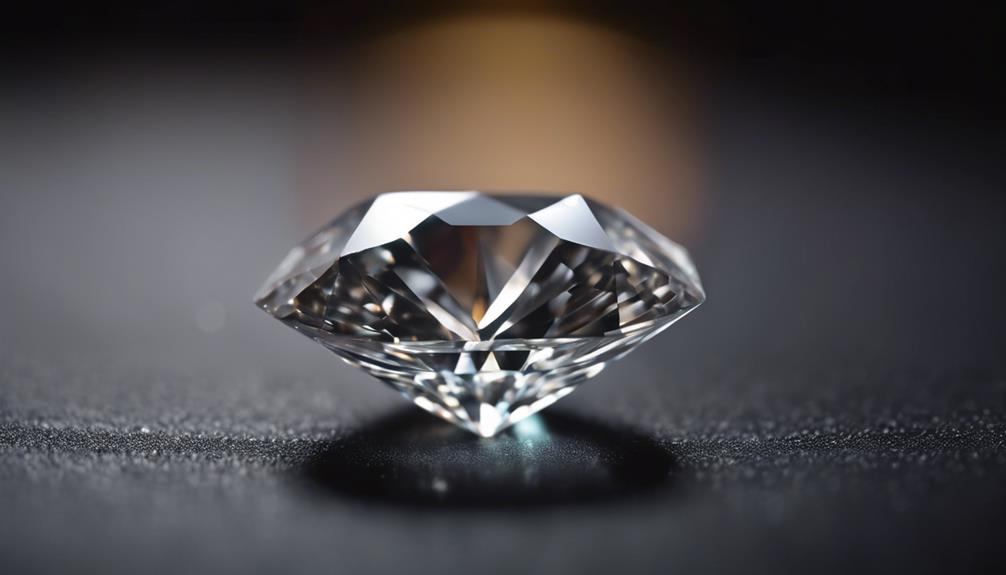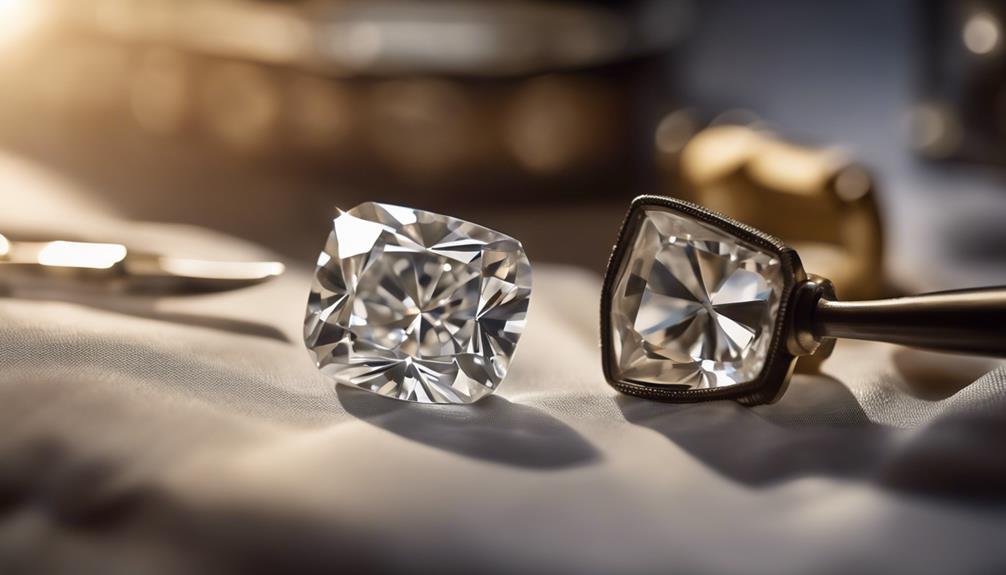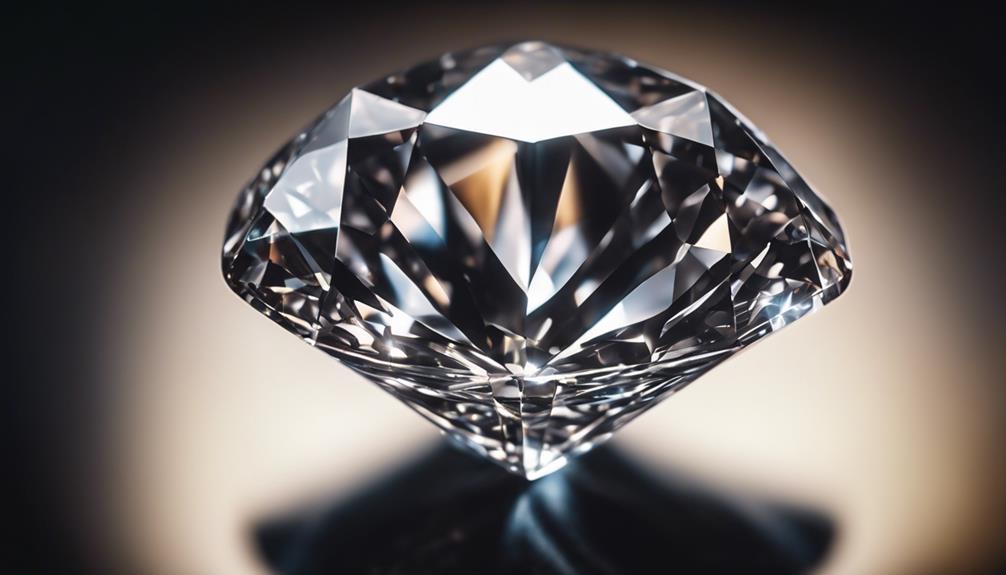A radiant cut diamond offers the brilliance of a round cut and the sleek shape of an emerald cut. Designed by Henry Grossbard in 1977, it features 70 facets to enhance its sparkle and fire. Beveled corners not only add to its durability but also make it perfect for everyday wear. This cut can appear larger than others of the same carat weight, giving you more value. However, evaluating its cut quality is essential since GIA doesn’t grade radiant cuts. For the perfect balance of sparkle, durability, and value, consider clarity and color grades carefully to maximize light performance. Discover more nuances that make this diamond unique.
Overview and Characteristics

Designed by Henry Grossbard in 1977, radiant cut diamonds combine the sparkle of round brilliant cuts with the elegant lines of emerald cuts. This unique combination results in a gemstone that not only dazzles with intense brilliance but also possesses a sophisticated, angular shape.
You’ll find that these diamonds are particularly popular for engagement rings due to their impressive sparkle and eye-catching appeal.
Radiant cut diamonds feature 70 facets, enhancing their brilliance and fire. These facets are meticulously arranged to maximize light reflection, giving the diamond an extraordinary shine. One of the standout characteristics is their beveled corners, which not only add to their aesthetic appeal but also improve durability by reducing the risk of chipping.
When selecting a radiant cut diamond, it’s essential to review the cut quality, clarity, and color. Each of these factors considerably impacts the stone’s overall beauty and appeal.
The radiant cut’s unique design showcases clarity and color more prominently, making it vital to choose a stone with high-quality grades in these areas. With their blend of durability and sparkle, radiant cut diamonds are a stunning and practical choice.
Pros and Cons
Radiant cut diamonds offer a unique blend of brilliance and durability, making them an appealing choice for many buyers. One major advantage is their excellent brilliance, nearly comparable to round diamonds, which gives you a sparkling gem without the higher price tag. The beveled corners enhance durability, making it a great option if you lead an active lifestyle. Plus, radiant cuts often appear larger than other cuts of the same carat weight, providing impressive value for money.
However, there are some drawbacks to take into account. The lack of GIA cut quality grades for radiant diamonds means you’ll need to be extra careful when evaluating their cut quality. A poorly cut diamond can underperform regarding brilliance, so it’s essential to inspect this aspect closely.
Additionally, while they offer more durability than princess cuts, radiant diamonds have a smaller face-up area compared to round brilliant cuts, which mightn’t suit everyone’s taste. Finally, if you prefer traditional shapes, the modern look of a radiant cut mightn’t appeal to you.
Quality Considerations

When evaluating a radiant cut diamond, you’ll want to pay close attention to the cut quality, as it greatly impacts the stone’s overall appearance and brilliance. Unlike other diamond shapes, the GIA doesn’t provide cut grades for radiant cuts, so it’s essential to inspect the proportions and symmetry yourself. Look for even, well-proportioned facets that maximize light performance.
Clarity is another key factor. Radiant cut diamonds do a good job of hiding inclusions due to their brilliance, so you can often opt for a clarity grade of SI1 or SI2 without compromising beauty. These grades offer a great balance between quality and cost.
Color is also important. Radiant cuts can show color more than round brilliant cuts. Aim for a color grade of H or better to guarantee the diamond appears white and vibrant.
Comparison With Other Cuts
In comparing radiant cut diamonds with other cuts, you’ll find that each shape offers unique advantages and aesthetic qualities.
Radiant cuts, with their 70 facets, deliver exceptional brilliance, rivaling that of round brilliant cuts. They combine the sparkle of round cuts with the angular shape of emerald cuts, making them a versatile and eye-catching choice.
When you look at radiant versus cushion cuts, you’ll notice that radiants have more brilliance and fire due to their facet arrangement. While both cuts feature trimmed corners, radiant cuts boast distinct edges, whereas cushion cuts have a softer, rounded appearance.
Against princess cuts, radiants stand out for their durability. The beveled corners of radiant cuts make them less prone to chipping compared to the sharp corners of princess cuts. Additionally, radiant cuts often appear larger due to their elongated design, maximizing the perceived size of the diamond.
While round brilliant cuts are the benchmark for sparkle, they typically come at a higher price. Radiant cuts offer a similar level of brilliance at a more affordable cost. Your choice between these cuts will ultimately hinge on personal preference and the desired style for the recipient.
Buying Advice

To make the best purchase, focus on finding a radiant cut diamond with a GIA certification to confirm consistent and accurate grading. This assures you’re getting a quality stone that meets strict industry standards.
When shopping, keep a few key points in mind to make an informed decision:
- Clarity: Aim for SI1 or SI2 grades for the best value. Radiant cuts hide imperfections well, so you don’t need to pay extra for higher clarity.
- Color: Choose H or better for a bright, vibrant diamond. Lower grades may show a slight tint, which can affect the stone’s overall appearance.
- Cut Quality: While GIA doesn’t grade cut quality for radiant diamonds, look for excellent proportions and symmetry to maximize brilliance.
Conclusion
To sum up, radiant cut diamonds offer you a stunning blend of brilliance, durability, and value.
With their 70 facets and beveled corners, you’ll get a diamond that’s not only beautiful but also resilient.
While GIA certificates don’t include cut grades for this shape, paying close attention to cut quality, clarity, and color will help you find the perfect gem.
Immerse yourself in the world of radiant cut diamonds and discover why they’re an exceptional choice for any occasion.



